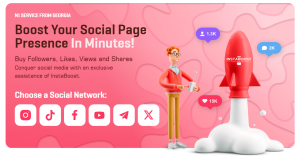
OfferUp clone
The e-commerce industry has evolved from a period of the old-fashioned one-way online store to real interactive and community-grounded e-commerce platforms. In other words, how social interaction, engagement, and immersion in shopping will actually look in the future of online commerce is not just virtual product browsing on listing pages, but social. It is, however, not so simple to naturalize the progression from an OfferUp model in the way it’s described here, wherein its functionalities should be introduced to those provided on social media platforms such as Instagram, YouTube, and Snapchat. Let’s consider how an OfferUp clone can unleash the social commerce potential and turn online selling and shopping upside down.
Social Shopping 2.0: Transforming Transactions with Social Integration
Social media is no longer just a place for connecting with friends or scrolling through pictures. Over the past few years, social commerce has emerged as a powerful force in online shopping. From Instagram shopping to Facebook Marketplace, platforms are becoming hubs where users interact with each other and shop in a dynamic and interactive environment.
An OfferUp clone that integrates social media elements can capitalize on this shift by transforming how people experience second-hand buying and selling. Instead of relying solely on listings, this clone could enable live interactions, video commerce, and instant feedback between buyers and sellers creating a more personalized and engaging marketplace.
Interactive Live Shopping: Real-Time Product Demos and Buyer-Seller Engagement
One feature that social media giants have adopted and seen success with is live shopping. Live-streaming platforms like Instagram Live and TikTok Live have revolutionized the way brands showcase their products. Imagine an OfferUp clone where users can host live video streams showcasing their products, offering real-time demonstrations, and interacting with potential buyers as they ask questions.
For instance, if a seller is listing a used car or a pet, they could create a live broadcast to walk viewers through the features, talk about the condition, and answer any queries. This approach mimics the in-person shopping experience, where customers can get immediate answers and feel more confident about their purchase.
By adding real-time interaction to the mix, buyers are more likely to trust the seller and feel a stronger connection to the product. This can increase conversion rates and create a more engaging shopping experience that traditional OfferUp-like platforms simply can’t provide.
Stories That Sell: Showcasing Products Through Temporary Content
We all know how Instagram Stories and Snapchat Stories work—brief, fun, and attention-grabbing posts that are up for 24 hours before disappearing. The ephemeral nature of these posts makes them more engaging, giving users a sense of urgency to watch and act quickly. By integrating this feature into an OfferUp clone, sellers could post time-limited content showcasing their products.
For example, a seller might upload a video showcasing a vintage bicycle or an artwork, demonstrating its features in a fun, quick format that captures the audience’s attention. Since these posts are temporary, they compel potential buyers to act quickly, pushing them to make a purchase before the content disappears.
What’s even more exciting is that these stories could also be interactive. Sellers could include polls, questions, or call-to-action buttons that let viewers engage directly with the content. Such features can significantly increase buyer engagement and interaction with the platform, bringing social media-style immediacy into the world of marketplaces.
Direct Communication: Chat and Video Messaging for Seamless Interaction
One of the core strengths of social media platforms is their emphasis on easy communication whether through chat, comments, or video calls. The integration of this style of communication into an OfferUp clone can provide a seamless experience for both sellers and buyers.
Instead of relying on traditional email or in-app messaging, an OfferUp clone could introduce real-time chat features or even video calls to facilitate better communication. Sellers could talk to potential buyers, show them products, and even provide live responses to any concerns buyers may have. For instance, if someone’s looking at a pet classified listing, they could quickly video chat with the seller to see the pet up close and get their questions answered on the spot.
This type of direct communication breaks down the barriers of uncertainty that come with online purchases, creating a more trustworthy and engaging marketplace where interaction is instant and personal. With real-time conversations, buyers feel more comfortable and confident, which can lead to faster decision-making and a more positive experience.
Video Commerce: Making Listings Dynamic and Engaging
The video revolution is here, and it’s transforming e-commerce at a rapid pace. Platforms like TikTok have shown how dynamic, short-form video content can drive engagement and sales. An OfferUp clone could implement a similar feature, allowing sellers to post video clips showcasing their products in action whether it’s demonstrating a car, home appliance, or even a pet.
These shoppable videos can be embedded directly into the platform, allowing users to browse listings and view videos without leaving the marketplace. Users can click on products shown in the videos, directly inquire about them, or even make a purchase instantly. This video-first approach makes products feel more tangible, offering a richer experience than static images or long text descriptions.
User-Generated Content: Building Trust and Fostering Community
When it comes to social commerce, user-generated content (UGC) is invaluable. Whether through reviews, product photos, or video testimonials, UGC creates a sense of community and authenticity, two things that are key to any marketplace. An OfferUp clone could encourage users to share their product experiences by uploading videos or writing reviews.
For example, a buyer who purchased a secondhand sofa could upload a quick video review showing the condition of the item and sharing their experience. Such content not only helps build trust with potential buyers but also fosters a sense of community within the platform. When users engage in sharing their real experiences, they feel part of the marketplace ecosystem, which strengthens user retention and loyalty.
Creating a Community-Centered Marketplace
By blending traditional online marketplaces with the engaging features of social media, an OfferUp clone has the potential to build a community-driven platform. This approach not only benefits sellers who can showcase their items in dynamic and engaging ways but also offers buyers a more interactive and personalized experience.
With live streaming, story-style posts, instant communication, and video content, a social commerce-enabled OfferUp clone would cater to the modern-day shopper who seeks not just a transaction but an experience.
In a marketplace where engagement and interaction are prioritized, the cloning of OfferUp could create a compelling and exciting platform that’s built for the future of social commerce. more







